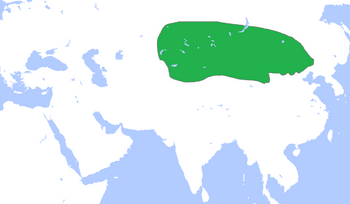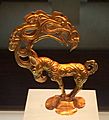Xiongnu facts for kids
Quick facts for kids
Xiongnu
|
|
|---|---|
| 3rd century BC–460s | |

Territory of the Xiongnu (green), circa 250 BC
|
|
| Capital | Longcheng (龙城/蘢城), near Khoshoo Tsaidam (present-day in Mongolia), was established as the annual meeting place and de facto capital. |
| Religion | possibly Tengriism |
| Chanyu | |
| History | |
|
• Established
|
3rd century BC |
|
• Disestablished
|
460s |
The Xiongnu (Chinese: 匈奴) were nomads who lived north of China from about 3rd century BC to 460s AD. Their lands were very infertile, so they tried to attack China many times. As this was very irritating, the first emperor of China (Qin Shi Huang) built the Great Wall of China around 214 to 206 BC to keep them out. Some Han dynasty emperors tried to stop the wars and make friends with them, but they still tried to attack the Chinese borders.
At first, it was believed that they were related to the Huns, and currently many people still believe this. In old times, nomadic tribes often travelled and lived together, even tribes speaking different languages. Around 60 BC, there was a struggle for power, and the Xiongnu broke up into five smaller tribes.
In 202 AD, the leader of the Southern Xiongnu surrendered to Prime Minister Cao Cao of the Han dynasty.
They are part of the Mongolian people now, or some of them have migrated to China for a better life.
Images for kids
-
Domain and influence of Xiongnu under Modu Chanyu around 205 BC
-
A Han Chinese glazed ceramic figurine of a mounted horse archer, 50 BC to 50 AD, late Western or early Eastern Han Dynasty
-
The Han dynasty world order in AD 2.
-
Southern and Northern Xiongnu in 200 AD, before the collapse of the Han Dynasty.
-
Men in Iranian dress on embroidered carpets from the Xiongnu Noin-Ula burial site. They have also been proposed to be Yuezhi. 1st century BC - 1st century AD.
-
Gold stag with eagle's head, and ten further heads in the antlers. An object inspired by the art of the Siberian Altai mountain, possibly Pazyryk, unearthed at the site of Nalinggaotu, Shenmu County, near Xi'an, China. Possibly from the "Hun people who lived in the prairie in Northern China". Dated to the 4th-3rd century BC, or Han Dynasty period. Shaanxi History Museum.
See also
 In Spanish: Xiongnu para niños
In Spanish: Xiongnu para niños











